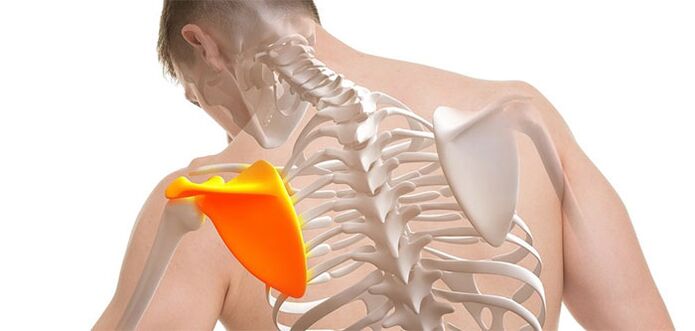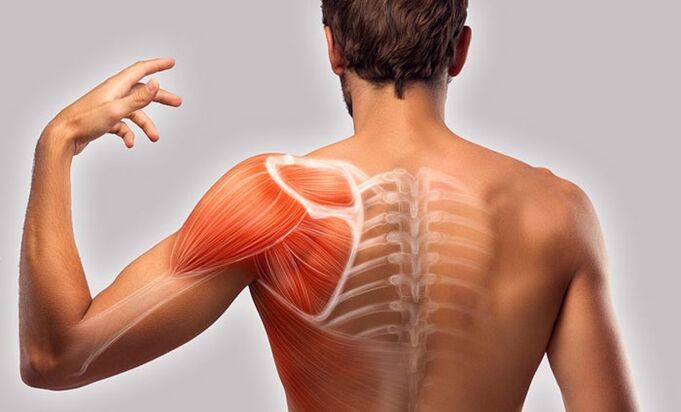Patients rarely pay proper attention to recurrent pain in the shoulder area. However, this symptom is a "wake-up call" of serious changes not only in the musculoskeletal system, but also in the internal organ-complex. Such conditions can threaten the patient with disability and death. How not to miss the disease and cure back pain in the shoulder area, read further.

Etiology
The spine is the main component of the human musculoskeletal system. So the lion’s share of pressure during statics or dynamics falls on the spine. Therefore, it is not surprising that a common reason for consulting a doctor is pain in the shoulder blade area.
However, pain syndrome is quite variable: often the pain is provoked not by the spine itself, but by a violation of the functions of the internal organs. This fact makes it difficult to diagnose the root cause of pain syndrome and leads to treatment errors.
Among the main causes of pain, pathologies of the musculoskeletal system and internal are distinguished.
The first group includes:
- osteochondrosis;
- spinal deformities;
- trauma and spondylolisthesis;
- spondylosis;
- osteoporosis;
- ankylosing spondylitis.
Among the non-vertebral causes, the most common are diseases of internal organs (pneumonia, heart attack, intercostal neuralgia, gastric ulcer, cholecystitis). Also, tumor processes or mental stamina (fibromyalgia, psychogenic pain) can provoke pain.
Pain variations
Why does the back hurt in the shoulder blade area? In general, pain syndrome can be localized both directly in the shoulder blade area and between them. The pain is bilateral (with scoliosis) or localized mainly on one side (gastric ulcer, cholecystitis).
By the nature of back pain between the shoulder blades, it can be acute (appear suddenly with a rapid increase in strength) or chronic (weak and prolonged). The main difference in practice is that the patient can accurately name the time of onset of acute pain syndrome. While remembering the circumstances of the onset of chronic pain will be difficult.
Pathology options
A variety of diseases can provoke back pain in the shoulder area, but we will focus on the most common of them.
- Osteochondrosis.Osteochondrosis is a disease during which "aging" of the intervertebral disc occurs. In advanced cases, such pathological changes lead to a hernial disc herniation. When the spine is affected by osteochondrosis, patients worry about a sharp back pain between the shoulders, which occurs when you bend over or stay in an uncomfortable position for long periods. It is possible to add palpable weakness of the back muscles, disturbances in the perception of temperature and pain.
- Spinal deformities.One of the causes of pain between and in the shoulder area is curvature of the spine. As a rule, the pain provokes kyphosis (flexion, bumps) or scoliosis (C, S or Z-shaped back). With pronounced deformities of the spine, painful pains appear, aggravated by physical activity. There are frequent episodes of respiratory failure (shortness of breath, inability to breathe deeply). The clinic is also associated with increased fatigue and headaches. In rare cases, the chest is bent.
- Injuries.Acute pain often manifests itself with direct trauma to the spine or the shoulder blades themselves. Similar injuries occur when you fall from a height, hit with a sharp object, transport or industrial accidents. Spinal cord injuries are associated with palpable pain, reflex back muscle contraction, and bruising. In some cases, the attachment of neurological pathology is possible. When the scapula is traumatized, the pain is acute, aggravated by arm tremors. Sometimes combined with hemorrhage in the shoulder joint cavity - hemarthrosis.
- Spondylosis.Spondylosis is called destructive senile processes in the spine. Usually, in the area of the intervertebral joints, bone tissue grows - osteophytes form, which can be complicated by the growth of vertebrae with each other. In such cases severe pain, neurological and vascular disorders appear.
- Osteoporosis.Osteoporosis is a disease associated with decreased density of the skeletal system. Usually, back pain in the shoulder blade area occurs when a thin thoracic vertebra fracture occurs. Postural curvature occurs - formation of scoliosis and / or kyphosis. In some cases, the disease is complicated by radicular syndrome (loss of motor activity and sensitivity).
- Ankylosing spondylitis. . . Ankylosing spondylitis is a disease that affects the intervertebral joints. Usually, the clinic starts with pain between the shoulder blades or in the lower back. The pain is accompanied by stiffness of movements, which intensifies after a night's rest. With the development of pathology, the spine is deformed, arched, which leads to chest curvature and respiratory failure. In such a pathological position, ankylosis (immobilization) of the intervertebral joints occurs, due to which the patient can no longer bend. In this case, the disease can also affect the cardiovascular and urinary system.
- Diseases of the internal organs.With pneumonia (inflammation of the lungs), a detailed clinical picture is characterized by fever, saliva production, and unilateral pain in the chest or back in the shoulder area. During a heart attack, the pain is sharp (knife, burn), defined in the chest and radiates to the left shoulder and upper limb. Pain syndrome with intercostal neuralgia is acute and piercing, manifested in the form of attacks that impede the patient's breathing. The pain appears along the ribs, spreads under the shoulder blades, the clavicle and the lower back. With a stomach ulcer, the pain is dull, localized in the upper abdomen, often accompanied by "hungry" pain (with long breaks between meals). In this case, the disease is characterized by digestive disorders, nausea, vomiting and sour belching. Sometimes there is bleeding from the ulcer: patients feel dagger pain, which disappears at the peak of bleeding. Vomiting and defecation become dark (almost black) due to blood impurities. Cholecystitis (inflammation of the gallbladder) is characterized by the appearance of a characteristic paroxysmal pain syndrome in the right hypochondrium, spreading to the right side and scapula. The clinic of the disease includes digestive disorders, the provocative factor of which is the consumption of fatty and fried foods. Sometimes vomiting occurs with biliary impurity.
- Tumors.Pain in the shoulder area may present with neoplastic diseases of the vertebrae or nerve sheath (neuroma). Metastases (daughter tumors) from the affected prostate or mammary glands can spread to the vertebral region. In this case, the tumor process is characterized by an asymptomatic course and the appearance of pain is accompanied by an increase in the neoplasm and its pressure on the neurovascular bundle. Cancer can be suspected by "watch dogs' symptoms": pain, weight loss, fever, and persistent weakness for no apparent reason.
- Mental instability.The psyche's instability to stress and emotional outbursts can manifest as psychogenic pain. It arises against the background of complete health: patients may experience various strong sensations that can not be treated even with sedatives. Stressful situations also provoke another idiopathic (unexplained) pain - fibromyalgia. The disease persists against the background of prolonged sensations of pain, intensifying at certain (triggering) points.
Diagnosing
Radiography is the gold standard for spinal examination. Computed tomography can be used to determine the cause of vertebral pain. Ultrasound or MRI is used to study other organs and systems. Laboratory or other instrumental examination methods may be needed to rule out concomitant pathology.
Treatment
These pathological conditions require a specific treatment plan; only a doctor can prescribe medication.
- Osteochondrosis.As a drug therapy to relieve pain, non-steroidal anti-inflammatory drugs and analgesics are used. Physical therapy, corrective gymnastics and massage are also effective. In the later stages of the disease surgery to remove the hernial sac is recommended.
- Spinal deformities.Conservative therapy for curvature of the spine consists of the use of support devices (corset, bandage). You also need enough activity, massage and physiotherapy (paraffin applications, electrical stimulation). In case of significant deformity, surgical methods of treatment are indicated to adjust the spine to the proper anatomical position.
- Injuries.Minor injuries are treated with rest, warmth and massage; more serious injuries may require traction. If conservative methods are ineffective, the spine is reconstructed with an operative method.
- Spondylosis.Treatment of this pathology aims to slow the progression of the disease. So, hyaluronic acid injections, chondroprotectors, physiotherapy (shock wave therapy), as well as physiotherapy exercises are prescribed. With severe pain syndrome, blockade is performed with sedatives.
- Osteoporosis.Osteoporosis care includes high doses of calcium and vitamin D supplements. Hormone therapy with female sex hormones, thyroid and other hormones is also possible.
- Ankylosing spondylitis.Inflammation and pain are controlled by anti-inflammatory therapy. To modify the immune response, an antimetabolite of the group of structural folic acid analogues is prescribed. During the prayer, physiotherapy, breathing exercises and therapeutic massage are performed.
- Diseases of the internal organs.Therapy for pneumonia includes antibacterial agents as well as medications that relieve bronchospasm. During the rehabilitation period, vibration massage and therapeutic exercises are prescribed. Intercostal neuralgia is treated with warming and anti-inflammatory ointments. Distraction therapy with local medicine with red pepper extract or bee venom is often used. Treatment of gastric ulcer consists of combination therapy with antibiotics, as well as with drugs that reduce the acidity of the stomach contents. Help with cholecystitis includes the use of antispasmodics and drugs that affect the bile ducts. In some cases, antibiotic therapy may be required. In the presence of large stones in the gallbladder, removal of the latter is recommended - cholecystectomy.
- Tumors.Treatment of tumor processes consists of chemotherapy with antineoplastic agents and surgical removal (if possible) of the neoplasm.
- Mental instability.Mental instability requires intensive psychotherapy as well as the use of antidepressants or anxiolytics. Limiting psycho-emotional stress is an important part of treatment.

How to prevent?
To prevent back pain in the shoulder area, lifestyle modifications are needed: increasing the nutritional value of the diet, sports, quitting smoking, and smoking. It is important to detect and treat chronic diseases in a timely manner, to avoid stress overload.
Remember, pain is not an independent disease, but a manifestation of a much more serious pathology that requires proper diagnosis and treatment!

























